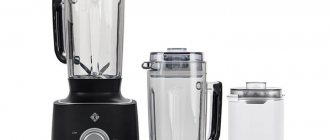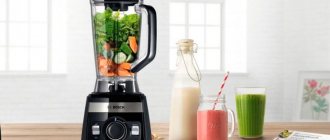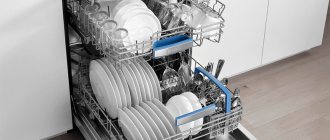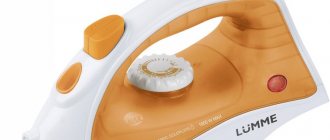What to look for when choosing a Redmond blender?
Redmond is a Russian brand that produces household appliances. The company offers a wide range of blender models. To choose a device, you need to pay attention to all the technical characteristics and quality of the product.
Power
Blender power can vary from 180 to 2200 W.
The larger it is, the faster the blender will complete the task. Some products require a certain power, for example, ice crushing must be carried out at 300 W.
Number of speeds
An immersion blender can have from 1 to 3 speeds, while a stationary blender can have up to 20.
For home use, only 3-5 speeds are enough. In addition, the mode is important: pulse is necessary for meat, nuts and ice, turbo is suitable for everything else.
Set of nozzles
There can be many attachments and with edges of different shapes:
- smooth edges stop splashing;
- wavy ones speed up grinding.
Types of nozzles:
- whisk for whipping;
- for making soups;
- knife - chopper;
- for crushing ice;
- for preparing minced meat.
Material
The case material is:
- metal - durable but heavy;
- plastic - lightweight, but can be damaged if used carelessly.
The bowl material is:
- glass - does not absorb odors, does not scratch, but can break;
- plastic - easy to use, does not break, but is scratched.
Overheat protection system
This function is necessary in cases where the blender is used for a long time and often. In this case, to avoid overvoltage, the device will automatically turn off after a certain number of minutes.
Power type
Power supply can be mains or battery powered.
The second type is very convenient when traveling and out of town. Mains power allows you to use the blender at home and in catering establishments.
If the blender is powered, it is important to pay attention to the length of the cord - it must reach the outlet.
Bowl size
Bowl size is very important when choosing equipment. Standard sizes range from 400 ml to 2 liters. It must be remembered that the container can only be loaded to 75%, this is necessary to avoid splashing.
Small bowls are suitable for chopping nuts, spices, cereals and for making baby puree. Large ones are for beating eggs, chopping meat and making cocktails.
About
Review of the Redmond RHB-2985 immersion blender
We test 3-in-1 blender kits quite often, and from a design point of view, the hero of our today’s review doesn’t really stand out. The developer (Redmond company) notes an increased service life, low noise level and double motor protection (which means stopping both when overloaded and overheated) as the main features of its new RHB-2985 blender.
Characteristics
| Manufacturer | Redmond |
| Model | RHB-2985 |
| Type | immersion blender |
| Country of Origin | China |
| Guarantee | 1 year |
| Estimated service life | 3 years |
| Declared power | 800 W (nominal), 1300 W (maximum) |
| Motor block material | plastic |
| Nozzle material | plastic, stainless steel |
| Material of the body and base of the kettle | plastic, stainless steel |
| Bowl material | plastic |
| Control type | mechanical |
| Smooth gear shifting | No |
| Number of speeds | 1 |
| Turbo mode | There is |
| Additional attachments | chopper knife, whisk |
| Motor protection against overheating and overload | There is |
| Weight | 1.75 kg |
| Dimensions (W×H×D) | 57×396×60 mm |
| Network cable length | 1m |
| Retail offers | find out the price |
Equipment
The blender comes in a box decorated in the Redmond corporate style. On a black background you can see photographs of the device, its individual accessories and a beautiful young lady, a description of the blender, its functions and technical characteristics. The box does not have a carrying handle, but one is not needed here: everything is packed very compactly.
Inside the package, the device is placed in cardboard inserts. All complete parts are kept in place thanks to a fairly tight packing, but it is not difficult to put the blender back into the box (for example, for transportation or long-term storage). Accessories are additionally packaged in plastic bags, some in air bubble film.
Opening the box, we found inside:
- the blender itself (motor unit);
- chopper bowl with lid;
- S-shaped chopper blade;
- blender attachment;
- whisk attachment;
- adapter for whisk attachment;
- mixing glass;
- manual;
- warranty card, service book and promotional materials.
At first sight
Let's take a closer look at the contents of the box.
The motor block of our blender is made of plastic. The main color is black, the secondary color is grey. Visually, the plastic looks like “semi-gloss” (as if it was previously glossy, but has become slightly dull from use). Thanks to this solution, the blender looks glossy on the one hand, and does not collect fingerprints on the other.
What elements make sense to pay attention to? The control panel of our blender consists of two mechanical buttons covered by a single rubber pad. The place where the power supply cable is attached is made in the form of a rubber plug that prevents the wire from breaking and other mechanical damage.
The connector for attaching attachments is plastic, cross-shaped. The locking mechanism is a spring-loaded latch that closes automatically and opens by pressing two buttons.
The blender attachment, made of plastic (at the junction) and stainless steel, looks standard. What attracts attention is perhaps the slightly unusual shape of the knife protection (with slots) and the not too large working depth of the attachment. The blade of our blender is two-bladed, slightly curved at the edges.
The whisk is standard: a plastic mount and a removable metal attachment.
The 600 ml mixing glass is graduated (from 100 to 600 ml in 50 ml increments, and from 4 to 20 oz in 2 oz increments). The plastic is ordinary - transparent, not too thick. We predict: scratches on such a glass will appear very quickly. There are no anti-slip rubber bands on the glass.
But the chopper bowl looks much more solid. Its plastic is just as transparent and scratch-resistant, but thicker. There are rubber anti-slip inserts at the bottom. There are graduations on the walls - from 100 to 500 ml in increments of 100 ml, as well as marks from 4 to 16 ounces in increments of 4 ounces. Using them it is unlikely that you will be able to accurately measure the required amount of products, but you can get an approximate idea of the volume of contents.
The chopping knife is standard, two-bladed. The lid fits well and is firmly attached to the bowl by turning it clockwise.
In our opinion, our blender has two potential “weak” points. The first (like all other immersion blenders) is the mechanism for attaching attachments. You will never guess how strong and durable this element will be.
The second is a rubber pad that protects the power buttons. Our experience is that over time (over several years) rubber can age, lose elasticity and eventually break. However, again, we are not able to make such predictions: how durable the materials will be can only be determined during actual use.
Instructions
The instruction manual is a 38-page black and white glossy paper brochure.
The instructions are written in three languages: Russian, Ukrainian and Kazakh. The Russian-language block is the first. The contents are all standard: safety measures, equipment, instructions for use, care and storage. There is a table of faults and ways to eliminate them. All manipulations (including rules for caring for the device) are duplicated in the form of pictures. There are no recipes.
Control
Operating the device is not difficult at all. The top button is the main mode (low speed of the blender), the bottom button is the turbo mode, in which the blender works at its maximum capabilities. There are no indicators or the ability to change the speed of the blender.
Exploitation
Before the first use, we performed the standard steps: we washed the bowls and attachments with detergent, and wiped the motor unit and gearbox cover with a damp cloth.
Working with the device turned out to be simple and predictable: place the products in a suitable container and grind (beat) at the desired speed. Hold the glass or container for grinding with your hand.
The volume level of the blender is average: when the device is running, it is quite possible to talk or watch TV at medium volume.
As for the time of continuous operation, the developer recommends adhering to the following rules for different modes:
- blender: 1-2 minutes of operation under load, recommended break - 10 minutes;
- mixer: 30 seconds of work under load, recommended break - 10 minutes;
- chopper: 1-2 minutes of operation under load, recommended break - 10 minutes.
This way we can get a general idea of how large-scale tasks we can entrust to our blender, and how productive it will be in real use.
Note that the lack of smooth speed control does not significantly affect the overall comfort of using the device, but requires some caution from the user: when working with liquid ingredients, it is very easy to splash the work area when you turn on the blender (for example, we did this a couple of times during testing ).
Care
The rules for caring for a blender are standard: wipe some of the parts (motor unit and plastic elements of the attachments) with a damp cloth (protect the gearbox from water), wash the rest under running water. Some elements (transparent glasses, chopper blades and whisk attachment) can even be washed in the dishwasher at a temperature not exceeding 60 degrees.
Our measurements
During testing, we measured the real power of the device when performing various tasks. It turned out that in all cases, without exception, the blender had a serious “reserve” in power: mayonnaise was prepared at a power of no more than 100 W, mincemeat was crushed at a power of up to 180 W, tomatoes - up to 260 W.
Practice tests
To evaluate the performance of the blender, we conducted a series of tests.
Chopping tomatoes
For the test, we used enough cream tomatoes to fill a blender glass.
It took about 30 seconds to grind until smooth.
We crushed the tomatoes for another 10-15 seconds, after which we decided to evaluate the result.
As we expected, the seeds and peel particles remained uncrushed in the finished mixture. A completely predictable result: the power of immersion blenders is not enough to obtain a completely homogeneous structure. The main thing in this case is that no unground pieces were found in the crushed tomatoes.
Result: excellent.
Mayonnaise
To prepare homemade mayonnaise, we use the following proportion of ingredients: for 250 ml of vegetable oil, take one egg, half a teaspoon of salt, one teaspoon of sugar, a tablespoon of vinegar and one teaspoon of mustard.
Combine all components with an equal volume of oil, beat with a blender at medium speed until a homogeneous emulsion is obtained and salt and sugar are dissolved, then increase the speed and add the remaining oil until the desired consistency is obtained.
This mayonnaise can be stored in the refrigerator for up to a week.
Our blender coped with the task without any problems. The mayonnaise turned out thick: a spoon will stand!
Result: excellent.
Forshmak
A traditional dish of Jewish cuisine - forshmak - is quickly and easily prepared using a blender. Well, for us this is the ideal way to test the chopper bowl.
For this test we took herring, hard-boiled eggs, a fresh apple, boiled potatoes and onions.
We started chopping with hard ingredients - apples and onions. We were generally pleased with the result: practically no large pieces were found in the bowl.
Then added all the other ingredients and continued grinding, shaking the contents of the bowl occasionally. Our goal was to get a smooth puree, so we crushed the contents of the bowl for 40-45 seconds.
We were more than satisfied with the result: the mincemeat turned out to be homogeneous, and the small particles of unground ingredients that are visible in the photo are what stuck to the walls of the bowl at the very beginning.
Thus, to achieve the perfect result, perfectionists will have to open the bowl at least once and stir the contents manually.
Result: good.
Greenery
We conducted another test of the chopping bowl with fresh herbs.
This time, the device coped with the task effortlessly: in just a few seconds, the contents of the bowl were chopped and evenly distributed over the walls of the bowl.
Result: excellent.
Smoothie (apple, banana, milk)
Finally, we decided to test how well the blender copes with preparing the most common smoothie made from apples, bananas and milk.
We pre-cut the ingredients into pieces of a suitable size and placed them in a glass for grinding. Then they added milk, leaving a safe distance to the edges of the glass, and began to grind.
The blender coped with the task without any problems. The smoothie turned out smooth, with no discernible unground pieces of bananas or apples.
Result: excellent.
conclusions
Overall, the Redmond RHB-2985 blender seemed to us to be an adequate device that copes well with its tasks. The only complaint: at this price, we would like to see smooth adjustment of the motor rotation speed. If this option is not mandatory for you, but you want to purchase a simple “3 in 1” blender, then the RHB-2985 will be a good candidate for purchase.
The device coped with all the tasks without any problems - mixed, crushed and chopped all the test products, while maintaining a decent power reserve.
The lack of smooth speed control in testing mode resulted in some splashes on the working surface (you need to be especially careful when starting the engine). However, we quickly adapted to this feature of the device - it turned out that we do not need to fill the grinding container to the brim, but the blender needs to be started by immersing it as deep as possible.
pros:
- performance
- copes with standard tasks with a reserve of power
- quiet
Minuses:
- lack of smooth speed control
- as a result, splashes are possible










